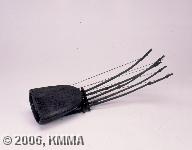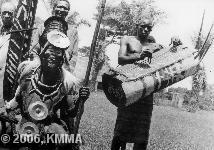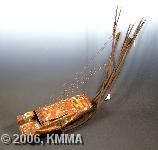









A musical instrument typical of the Central-African region is the pluriarc. The origin of its names lies in its construction principle. To the box-shaped soundboard several arches are fixed that each have their own string and thus each serve as a fingerboard. The form of the soundboard varies from a simple rectangular box to a more rounded elegant form. The soundboard of the instrument is distinguished by its different forms and decorations. Occasionally, the soundboard also has abstract geometric lines and figures. Build, type of soundboard and decorative style determine the identification of the tribe that built the instrument. The strings of the pluriarc are always made from vegetable fibres.
The cross-section of the sound box ranges from a tight rectangle to a more rounded form, while its longitudinal section is generally rectangular. The upper board of the instrument, the soundboard, is distinguished by its size and the way it is attached to the sound box (bound, nailed or made from one piece). The fingerboards can be classified by their number, often five for the same number of strings. Other characteristics are: the presence of a bridge, specific decorations on the sound box and soundboard and the presence of anthropomorphic or animal images. Typical are the ‘arcs’ from the Lower Congo where a human face is introduced into the extension of the sound box and where the fingerboards start.
The most common names are lu(o)kombe (i), longombe(i) where the tribe –kombe and –ngombe stand out.
Lukombe (Bokuma, Ngando, Yaelima, Lia, Sengele, Sakata, Ntombe, Songo Meno), longombe (Bokatola, Bondongo, Nkundo, Lia , Eso), longombi (Mongo), lokombi and lokombe (Ekonda, Oli, Mongo, Lia, Bai), lokumbe (Tumba, Titu, Ipanga). Other names include: esandju (Mongo), lakwemi (Kuba), sambi (Sango), ngwomi (Teke), ngwen (Yans) and lusinga (Muanda).
The larger examples have three strings, like the lokombi lomkunu of the Ekonda, and are mostly played with a plectrum, while the pluriarc of the smaller type, which has five or more strings, are plucked with the thumb and the fingers. The plectrum may be a small twig, but is usually a piece of braided and dried liana fibre. Generally the instrument produces very low tones, providing a simple bass accompaniment which can be better described as rhythmic rather than melodious.
The art of playing the pluriarc does not require a great deal of technical mastery, but is better known for the songs and the words that are performed. The player is expected to know a wide range of texts, stories and historical names and events by heart, and to be able to perform them in a captivating manner.
To play, the musician supports the back of the pluriarc on one thigh and with the other thigh can open or close the sound opening on the underside to obtain timbre variation. Another method of playing involves sitting down and placing the instrument against the knee in parallel with the shinbone. Among the Mfinu, the pluriarc is played in an unique manner; its strings can be shortened by hand to obtain different pitches whilst playing. This more melodic use of the instrument demands greater technical skills.
The pluriarc is played on a variety of occasions: for the accompaniment of individual songs, dance, hunts, iron melting and rituals (fetishism, enthronement, funeral). The instrument is also played at public events, in orchestras, and is also played solo in private settings. At the funeral of a prominent person, both their qualities and the lesser details of their life are commemorated in song. Sometimes the playing goes on for hours, and the musician is carried around whilst playing.
This type of instrument is used in recordings of our sound archives made with the Congolese peoples mentioned hereafter where it appears with the following vernacular names:
Longombe (Nkundu), Lungoyngoy (Kongo), Motumbe (Ngombe)
Bibliography:
Discography:
© KMMA